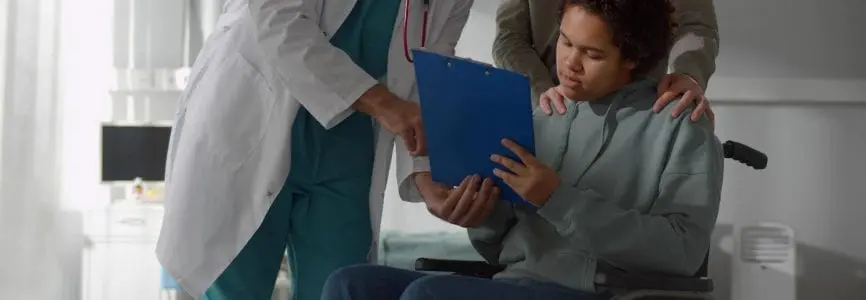Bioethics Forum Essay
Ethical Challenges in Discharge Planning
After suffering respiratory failure in her second semester of college due to a rare progressive neuromuscular disease, Michelle Brose found herself in the hospital contemplating life on a ventilator. She had heard about a doctor at a rehab facility working with noninvasive ventilation, but her insurance company wouldn’t cover it. “I continued to refuse to consent to the nursing home, having heard from disability activists long before my hospitalization that no one can force you into a nursing home against your will, but that they can withdraw care,” she writes.
What could “withdrawal of care” look like for a person who can no longer breathe without a ventilator? In Brose’s case, she realized, it meant the insurance company was now threatening to refuse payment for her entire four-month hospital stay. Hospital administrators were determined to get her to a nursing home and out of their care as soon as possible. “Living the rest of my life in a nursing home, unable to move or speak or even get a deep breath, was unfathomable to me. Death would be preferable,” Brose states.
Brose’s story is one of the narratives included in a symposium titled “Ethical Challenges in Discharge Planning: Stories from Patients” in the current issue of Narrative Inquiry in Bioethics. (Brose’s story can be read here.)
The symposium editor, Elizabeth Pendo, reminds us that millions of patients are discharged from a hospital each year and that “the individual and systemic forces that shape discharge planning and care transitions” frequently lead to “failures that compromise patient health and well-being.” As many health care workers and patients know, however, there can be a complex set of obstacles to maneuver in creating a discharge plan. Ethical issues abound and discharge plans are typically made without a clear framework for integrating the clinical and personal concerns of all parties involved.
The symposium offers a look into discharge planning from a patient’s perspective. The stories shed light on some of the ethical considerations of care transitions, especially the challenges faced by vulnerable patients. Symposium commentator Lisa I. Iezzoni notes that Brose’s story is an example of the open secret that “financial incentives often motivate hospital discharge timing.” This fact, along with other factors such as “systemic communication failures,” Iezzoni writes, contribute to the “relatively poor health outcomes” of the American health care system.
Monu Chhetri’s narrative describes one of the systemic communication failures. (Note: this story was told by Monu Chhetri to Rebecca Garden in two stages through two American Sign Language interpreters. Chhetri reviewed the final version with an interpreter.) A professional Deaf Nepali Sign Language interpreter and a refugee from Bhutan, Chhetri told her story of attempting to understand her daughter’s health care in the hospital. When her daughter was rushed from school to the emergency room, Chetri tried to understand the frightening situation with limited ability to communicate with the health care team. She asked for an interpreter, but none appeared. “When I wasn’t provided an interpreter,” she explains, “I felt very oppressed. I wanted to know my daughter’s medical condition so I could take care of her appropriately at home. It felt like the doctors and nurses were really discounting me, like I was of no importance whatsoever.”
Chhetri’s story sheds light on the importance of clear communication between doctors and patients, particularly in discharge planning. In the U.S., there is “such amazing medical care,” she says; however, “just a simple miscommunication could prevent my daughter from getting the medical care that she needs and cause her further suffering.”
Even health care professionals can feel blindsided by the discharge process. Despite being a physician in the hospital where he sought care for appendicitis, Brent R. Carr felt bewildered by his abrupt and unceremonious discharge. Standing in the hot parking lot, holding his car keys and the small yellow paper containing his discharge instructions, Carr wondered if he had been accidentally discharged prematurely. He was in pain and, he thought, it was strange he had not been accompanied to his car. The discharge paper contained only two sentences. When his painful post-operative symptoms became significant and not explained by the yellow paper, Carr decided to use his connections. “I admit to cheating,” he writes. “I would call the surgeon directly—doctor to doctor.” Most patients, as Carr notes, don’t have that string to pull.
Kristi L. Kirschner suggests, at the end of her commentary, that she expects that the structural burdens preventing effective discharge planning also cause moral distress for many doctors. “Though they have a fiduciary responsibility to put the interests of their patient first,” she writes, “in the absence of structural supports, it is easy to burn out.” The narratives in the symposium focus on the patient perspective of ethical challenges in discharge planning, but the stories also expose the larger architecture of a health care system that allows many patients to fall through the cracks during the transition of care. The solutions, like the problems, need to be systemic. The first step, as always, is to see the problems clearly.
Mary Click is a former communications assistant at Washington University School of Medicine in St. Louis.














The complexity of discharge planning reflects a flaw in the system, whereby greater significance is placed on the pre-operative care of patients with little attention on their aftercare. What is a lot more unclear is whether this issue should be subject to legal mandates or whether conditions are too contextual and unrealistic for a blanket approach to discharge services. The impracticality component speaks to the resources of the hospital in question and the admission rate. As was stated in the text, oftentimes healthcare providers are shocked by the news that a patient has been discharged, which speaks to their inability to exercise autonomy in what they feel is best for their patient. Even worse, discharge planning seemingly violates all principles of bioethics on top of destabilizing the fiduciary relationship between patients and providers. Patients can opt or consent to services but often the choice to discharge is by force. Then, as stated herein, justice principles are also often precluded by whether or not patients are insured. These decisions may not be in the best interest but rather what is in the interests of the hospital once the patient has received care. The challenge here is the system in and of itself. There are two phases in the patient process: the give and take. Once patients enter the “take” phase, where they are benefitting from services at a rate that is disproportionate to what the hospital is earning from their stay, they take up space and use up medical devices that ostensibly could be benefitting from another patient. The idea that medicine should only be the intervention is misguided and creates a cycle where you can get treated but without proper aftercare, you’re back in the hospital. Of course, the idea that we should focus more on patient care is not that simple. Undoubtedly, hospitals are in many ways a business. If patients are available to stay they will take up space that could be used for other patients. This idea is why there should be a policy change involved. There should be a greater focus on discharge based on medical necessity rather than financial constraints. Perhaps a legal mandate that requires providers to oversee the well-being of their patients for two weeks after intervention would be satisfactory, but there are a lot of problems that could arise, especially given time constraints and staffing. Nonetheless, if the duty is to the patient and the wellness, this tension should be adjudicated. Undoubtedly care should continue beyond the confines of the hospital. Leaving this decision at the hospital’s discretion would create deserts of comprehensive medical care throughout the country and most likely would concentrate better care to well-funded hospitals and clinics.